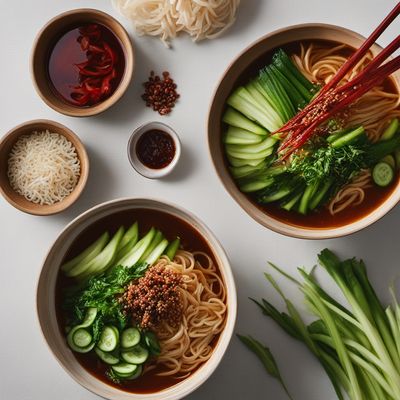
Recipe
Bibimbap
The Ultimate Bibimbap: A Flavorful Korean Delight
4.9 out of 5
Bibimbap is a beloved Korean dish that has gained international popularity. In Korean cuisine, it is a staple and a true representation of the country's vibrant flavors. This recipe will guide you through creating a delicious Bibimbap, adapted to the authentic Korean cuisine, ensuring an explosion of flavors that will transport you to the streets of Seoul.
Metadata
Preparation time
30 minutes
Cooking time
20 minutes
Total time
50 minutes
Yields
4 servings
Preparation difficulty
Medium
Suitable for
Vegetarian, Gluten-free, Dairy-free, Nut-free, Low-fat
Allergens
Soy, Sesame
Not suitable for
Vegan, Paleo, Keto, High-protein, Low-carb
Ingredients
-
2 cups (470ml) cooked short-grain rice 2 cups (470ml) cooked short-grain rice
-
1 cup (150g) julienned carrots 1 cup (150g) julienned carrots
-
1 cup (150g) julienned zucchini 1 cup (150g) julienned zucchini
-
1 cup (150g) bean sprouts 1 cup (150g) bean sprouts
-
1 cup (150g) sliced shiitake mushrooms 1 cup (150g) sliced shiitake mushrooms
-
1 cup (150g) spinach 1 cup (150g) spinach
-
1 cup (150g) thinly sliced beef 1 cup (150g) thinly sliced beef
-
4 eggs 4 eggs
-
4 tablespoons gochujang (Korean chili paste) 4 tablespoons gochujang (Korean chili paste)
-
4 tablespoons soy sauce 4 tablespoons soy sauce
-
2 tablespoons sesame oil 2 tablespoons sesame oil
-
2 tablespoons vegetable oil 2 tablespoons vegetable oil
-
4 cloves garlic, minced 4 cloves garlic, minced
-
Salt, to taste Salt, to taste
-
Sesame seeds, for garnish Sesame seeds, for garnish
-
Kimchi, for serving Kimchi, for serving
Nutrition
- Calories (kcal / KJ): 450 kcal / 1884 KJ
- Fat (total, saturated): 12g, 3g
- Carbohydrates (total, sugars): 65g, 5g
- Protein: 20g
- Fiber: 6g
- Salt: 2g
Preparation
-
1.In a large skillet, heat 1 tablespoon of vegetable oil over medium heat. Add the beef and cook until browned. Remove from the skillet and set aside.
-
2.In the same skillet, add another tablespoon of vegetable oil. Sauté the carrots and zucchini until slightly softened. Remove from the skillet and set aside.
-
3.In a pot of boiling water, blanch the bean sprouts for 1 minute. Drain and rinse with cold water. Set aside.
-
4.Blanch the spinach in the same pot of boiling water for 30 seconds. Drain and rinse with cold water. Squeeze out any excess water and set aside.
-
5.In a small bowl, mix together the soy sauce, minced garlic, and sesame oil. Set aside.
-
6.In a separate skillet, heat 1 tablespoon of vegetable oil over medium heat. Crack the eggs into the skillet and cook until the whites are set but the yolks are still runny.
-
7.Divide the cooked rice among four bowls. Arrange the beef, carrots, zucchini, bean sprouts, spinach, and shiitake mushrooms on top of the rice.
-
8.Place a fried egg on each bowl and drizzle the soy sauce mixture and gochujang over the ingredients.
-
9.Garnish with sesame seeds and serve with kimchi on the side.
Treat your ingredients with care...
- Beef — For a vegetarian version, substitute the beef with tofu or tempeh.
- Gochujang — Adjust the amount of gochujang according to your spice preference.
- Kimchi — Use store-bought kimchi or make your own for an authentic touch.
Tips & Tricks
- To achieve a crispy rice crust, leave the rice in the bottom of the bowl for a few minutes before mixing.
- Experiment with different vegetables such as mushrooms, bell peppers, or cucumber.
- Add a dollop of Korean fermented soybean paste (doenjang) for an extra depth of flavor.
- For a vegetarian version, omit the meat and add more vegetables or tofu.
- Serve with a side of Korean seaweed soup (miyeokguk) for a complete meal.
Serving advice
Mix all the ingredients together thoroughly before eating to enjoy the harmonious blend of flavors. Serve hot and enjoy!
Presentation advice
Arrange the colorful ingredients in a circular pattern on top of the rice, with the fried egg placed in the center. Drizzle the sauces over the ingredients in an artistic manner. Sprinkle sesame seeds on top for an added visual appeal.
More recipes...
For Bibimbap » Browse all
For Korean cuisine » Browse all
More Korean cuisine dishes » Browse all

Naengguk
Cold soup with beef and vegetables
Naengguk is a Korean cold soup that is perfect for hot summer days.

Sujebi
Hand-pulled dough soup
Sujebi is a Korean traditional soup made with hand-pulled dough flakes and vegetables. It is a popular comfort food in Korea, especially during...

Kimchi jjigae
Kimchi Stew
Kimchi jjigae is a traditional Korean stew made with kimchi and pork. It is a spicy and flavorful dish that is perfect for cold weather.







